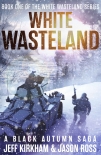Honor Road, Jason Ross [good romance books to read txt] 📗

- Author: Jason Ross
Book online «Honor Road, Jason Ross [good romance books to read txt] 📗». Author Jason Ross
He couldn’t care less who might hear.
5 Sage Ross
South of Lowden, Washington
Southeastern Washington State
As so often happens in the wilderness, a seemingly small problem became a life-threatening problem within an hour. Sage’s boots had filled with ice-cold water. His socks slurped and sloshed in his boots and on the skin of his feet. Water-logged and soft, the skin of his feet was wearing into fleshy pulp at an alarming rate. He could feel wet blisters bulging with every step.
The tongue of his boot had been scooping up the slightest scrim of snow with each boot rise. Then the snow wicked its way down to his foot via the sock. Even the tiniest kernel of snow, scraped with each step, thousand of footfalls a day, eventually became a boot-full of water.
He’d dumped his boots and wrung out his socks a dozen times so far that morning, and even so, he hiked in a constant state of wetness. There was no way his feet would tolerate even a hundred miles of backpacking like this, much less six hundred.
After two and a half days of hiking through the snowfields of eastern Washington, Sage’s feet had reached the end-of-the-line. He’d learned that his brain, not the contents of his pack, was the ultimate survival tool. He needed to stop and think.
A rough circle of vehicles sat ahead under a cluster of giant elms, and the snow around it remained smooth and untouched. It looked good for the night, but he stopped and waited anyway. An ironclad rule; Sage always spent ten minutes glassing an area before approaching.
He counted down from 600 while watching the cluster of cars through his binoculars. Nothing moved. If he could shelter in one of the vehicles for the night, it’d partially block out the light of a fire. He didn’t need the warmth to sleep—he had many layers of clothes for that—but fire was the only way to dry out his socks and boots.
He finally approached with his 30-30 rifle leveled, safety off. He found no surprises, the new-fallen snow was untrampled and the cars were frosted with several inches. Nobody had been there in days.
Sage yanked open a car door with his left hand, covering the inside of the car with a one-handed grip on his 30-30. In the bottom of the footwell lay a small, dead dog. The cold must’ve preserved the corpse, since the smell of decay barely registered.
The loneliness hit him so hard he almost had to sit down. The sight of the little, mangy mutt, so well preserved, sparked a ferocious hunger for companionship. He wished the dog would look up and blink back death.
Who the hell would leave a dog locked in a car to starve?
These days, if someone came upon a dog, even dead, they’d probably eat his rotting corpse. Sage leaned on the door frame and set the 30-30 against the side. It struck him for the first time, the sheer amount of resource contained in a modern automobile. As he looked around the passenger compartment for food, he made note of the treasure trove—plastics, vinyl, stuffing, containers, oil products, flammables, hardware and elastics. The quantity of manufactured goods made him think: how could he solve his boot issue with car parts?
He assumed, since they’d been abandoned, that none of the cars contained enough gasoline to travel, so he wouldn’t bother trying to find keys or check the tanks. Driving down a road, in any case, would be like begging for bullets. He hadn’t seen a moving vehicle in weeks.
It was still early in the afternoon, maybe three o’clock, and Sage had his work cut out for him. He got a fire going in the center of the circle of cars and set his boots on elmwood spikes, unlaced with the tongues open, to encourage them to dry. He dug around in the snow for stones, and put them under the burning sticks, where the coals would heat them. While the fire dried his boots and heated the stones, he went to work on the cars, cutting away raw materials with his heavy Glock knife.
After trimming and testing the pliability of the seat leather, floor mats, and headliner, Sage settled on the headliner of an Aerostar minivan as the best material for boot gaiters. It provided the best combination of flexibility and impermeability.
While he’d sloshed along earlier that day in his boots, it’d dawned on him that he’d seen, but never used, boot covers for hiking in the snow. In a mental “gap,” he’d even remembered the name for them: “gaiters.” They were like stretchy tubes that sealed the space between boots and pants. If he could make a pair of gaiters, it’d stop the snow from scraping into his boots.
After almost two hours of trial-and-error around the firelight, Sage produced a pair of gaiters made of headliner and seatbelt cinches. After testing them for a couple days and making modifications, he’d finish the hems with his tiny sewing kit.
By the time he completed his gaiters, night had fully descended.





Comments (0)